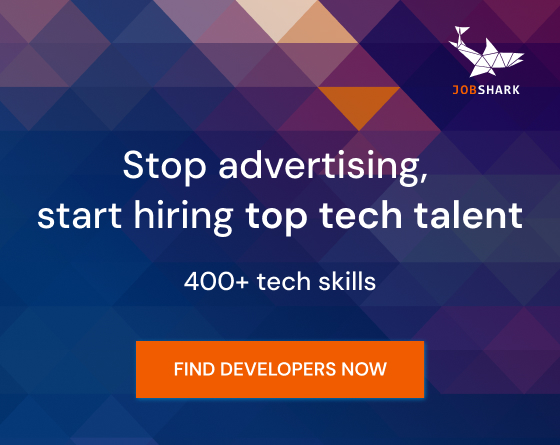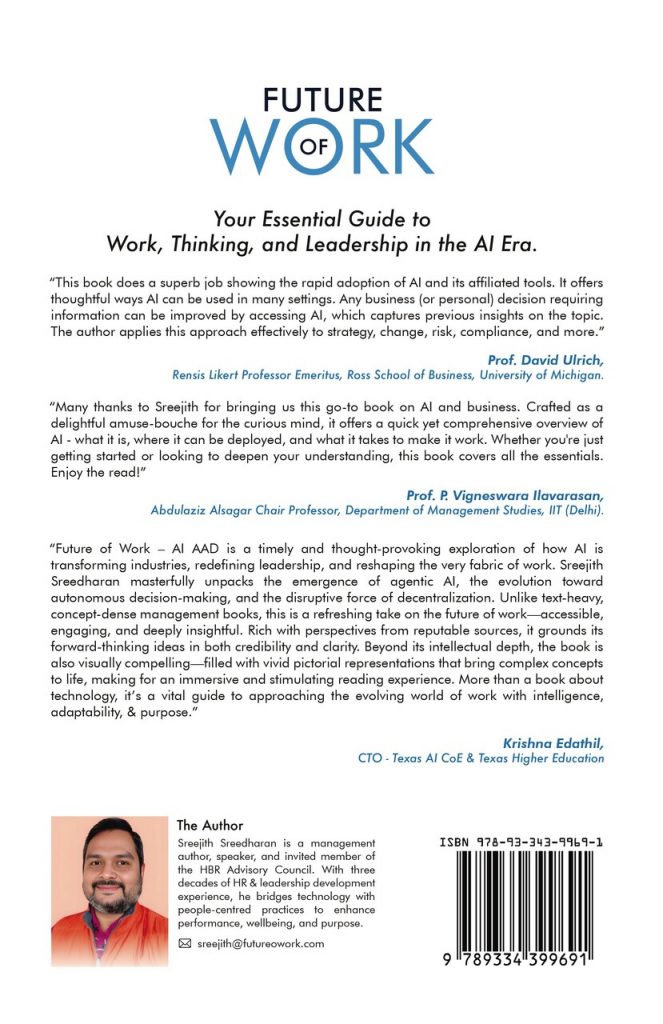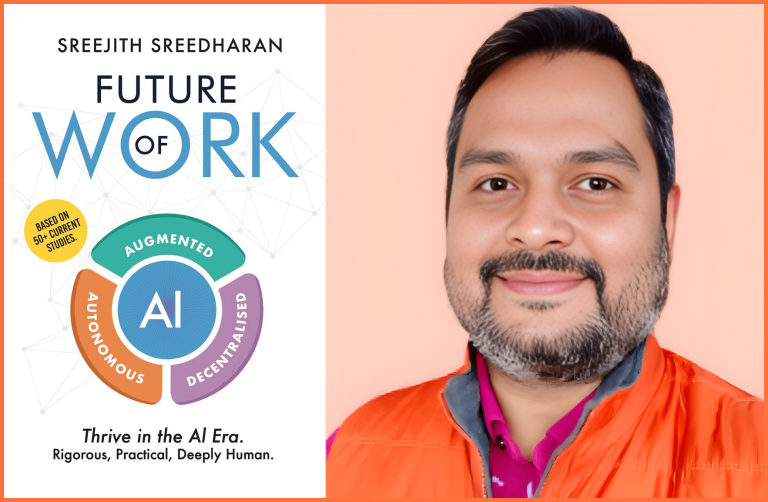After more than 20 years of experience in global HR management, Sreejith Sreedharan has turned his gaze to what is yet to come. He is launching “Future of Work – AI Augmented, Autonomous, Decentralized,” the second volume in his trilogy on applied AI, aimed at a non-technical audience.
The new book has received endorsements from influential HR leaders, including Dave Ulrich, often called the “father of modern Human Resources.” The launch event will take place at the National University of Singapore on November 14.
Based in Bangalore, India, Sreejith Sreedharan brings a global perspective shaped by his experience leading multicultural teams across regions. His framework — centered on augmentation, autonomy, and decentralization — transcends geography.
Augmentation refers to how AI takes on routine tasks, freeing people to focus on creative, higher-value work. Autonomy refers to AI systems acting independently within limited domains, yet remaining under human oversight. Finally, decentralization highlights the cost reductions made possible by AI, which will increasingly enable small teams to compete effectively with larger organizations — one of the most exciting prospects of the AI era.
The author acknowledges AI’s current limitations — such as bias, hallucinations, inference errors, vulnerabilities, and reliability issues — but considers these manageable risks. He defends viewing AI as a pattern-recognition system requiring human interpretation and oversight.
In this interview with TechTalents Insights, Sreedharan discusses other key issues surrounding artificial intelligence — its impact on the labor market and its environmental footprint.
Regarding AI’s influence on employment, Sreedharan evaluates that Amazon’s recent layoff of 14,000 corporate employees cannot be attributed solely to AI: “Economic uncertainty, geopolitical changes, and corporate restructuring are also key factors.” He adds that AI is expected to create new job roles in the coming years, with the overall trend pointing toward a net increase in employment.
On the environmental costs of AI adoption, he emphasizes that organizations should integrate sustainability metrics into their technology roadmaps.
Sreedharan expands on these ideas in the conversation that follows.
TechTalents Insights: In your book, you emphasize that workplaces must adapt to include non-human actors and that organizational behavior must evolve to include machine behavior. What does that look like in practice today? And what changes do you expect next?
Sreejith Sreedharan: Organizational behavior continues to be predominantly human-centric in the current context. Agentic AI is still in its early adoption stage. However, in the next 3 to 5 years, the scenario could change significantly as AI adoption accelerates.
Understanding what both humans and AI can do best, individually and collaboratively, could form the basis of a new framework for Organizational Behavior.
The emergent behavior of agentic AI could pose challenges. The greater challenge, however, goes beyond technological integration; it lies in establishing accountability when AI makes decisions or errors, ensuring human oversight in critical judgments, and aligning these advancements to enhance employee well-being and organizational purpose rather than serving profit alone.
TechTalents Insights: You advocate for leaders cultivating humility, curiosity, and a focus on well-being. How should leadership education evolve to prepare future managers for AI-augmented environments?
Sreejith Sreedharan: Current leadership paradigms will be forced to evolve into a more humane and employee-centric model, rather than a top-down, military-inspired command and control. AI-augmented and empowered employees do not need patronizing leadership behaviors or hierarchical structures. Hence, leadership education must evolve toward models grounded in empathy, curiosity, and collaboration.
In AI-augmented environments, managers must learn to lead empowered teams where decision-making is more distributed and trust-based. Emotional intelligence, ethical reasoning, and human–machine collaboration skills could form some of the core concepts of future leadership paradigms.

TechTalents Insights: Amazon is cutting 14,000 corporate jobs as it aims to become leaner in the age of AI. The Business Insider reported that the era of “mega AI layoffs” has arrived. How do you interpret these developments? What does this moment reveal about the future of work?
Sreejith Sreedharan: These developments are cautionary signs rather than proof of a technology-driven collapse in employment. While large-scale layoffs draw attention, it would be simplistic to attribute them to automation alone. Economic uncertainty, geopolitical changes, and corporate restructuring are also key factors.
Fears that intelligent AI systems will cause widespread job loss are mostly exaggerated, as their broader impact on the economy will take years to unfold. Most roles expected by 2030 have yet to be defined, according to recent authoritative employment and labor reports from around the world, which attest to the trend of net employment generation. This shows that work is evolving, not disappearing, thanks to AI.
This moment is best seen as a period of transition in which organizations are learning to adapt technology thoughtfully while creating new forms of work and value.
TechTalents Insights: In your book, you note that, unlike technologies such as the steam engine or the internet that unfolded over decades, AI’s adoption timeline is highly compressed. In what ways does this speed influence the human and organizational capacity to adapt?
Sreejith Sreedharan: The accelerated pace of technological change places enormous pressure on both human psychology and organizational adaptability.
“Unlike earlier industrial shifts that unfolded over decades, today’s AI transformation allows little time for emotional or cognitive adjustment.”
This makes psychological readiness a critical but often overlooked factor in successful adoption.
With five generations now coexisting in the workforce, differences in technological exposure, motivation, and learning preferences greatly influence how quickly organizations can adapt. Everett Rogers’s Diffusion of Innovation theory remains relevant here, as it explains why early adopters and laggards will coexist even within the same organization. The challenge, therefore, lies not in introducing new tools but in creating environments that support trust, curiosity, and continuous learning across all age groups.
TechTalents Insights: You’ve announced the third and final book in your Future of Work series for next year. What new dimensions or case studies will it explore?
Sreejith Sreedharan: I’m currently working toward concluding the book soon, which is expected in 2026. It will focus on the environmental, social, and governance dimensions of intelligent and emerging technologies such as AI, blockchain, quantum computing, and bio-computing.
The book will also delve deeper into how leadership and management are evolving as intelligent technologies become increasingly integrated into every aspect of life.
Every technological advancement comes with trade-offs, especially when resources are finite and access remains uneven. This book will explore how innovation can be aligned with sustainability and ethical responsibility, using real-world case studies to illustrate both progress and pitfalls.
The trilogy as a whole aims to offer an accessible, holistic understanding of the evolving relationship between humans and technology. Awareness of these developments is no longer optional; even with its imperfections, intelligent technology like AI remains one of humanity’s most defining and transformative achievements.
TechTalents Insights: How do you think organizations (and policymakers) should address the environmental costs of AI while still encouraging AI adoption?
Sreejith Sreedharan: Addressing the environmental costs of advanced AI technologies while fostering their adoption requires a balanced, multi-stakeholder approach.
Current development practices have placed immense strain on planetary resources through high energy and water consumption, and these effects are compounded by unequal access to infrastructure, capital, and talent between the Global North and South.
To mitigate these disparities, policymakers must incentivize research on energy-efficient models, technology transfer, promote the use of renewable power in data centers, and establish transparent reporting standards for environmental impact.
Organizations, for their part, should integrate sustainability metrics into their technology roadmaps, invest in localized AI capabilities to reduce dependence on large centralized infrastructure, and collaborate globally to share knowledge and best practices.
The real challenge lies in ensuring that technological progress narrows, rather than widens, the existing digital and wealth divide, fostering equitable and responsible innovation across all regions. Yet, history shows that technology has more often amplified these inequalities than reduced them. Concerted and determined action by governments, policymakers, and organizations is therefore essential to reverse this trend and build a more inclusive technological future.

Subscribe to our newsletter
Enjoying our content? Subscribe to the TechTalents Insights newsletter and get our best articles and interviews delivered directly to your inbox. Click here to join the community!




